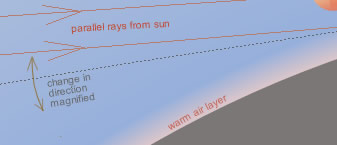
OPOD
What's New
Rays & Shadows
Anti-crepuscular
Cloud shadows
Mountain Shadow
Earth's Shadow Blue Sky
Sunsets
Sunset Mirages
Green Flash
Green rim
I-Mir flash
Formation
M-Mir flash
Observing
More Images Moonrise/set
Opposition effect
Water Droplets
Rainbows
Ice Halos
High Atmosphere
Links & Resources
Search - Index
123456789012345678
| Inferior mirage & green flash formation |
|
|||||||||||||
| Warm air immediately above the ocean causes the sun's rays to be mirrored back upwards. The rays produce an inverted sun beneath the 'real' one. When the sun has almost set the mirroring becomes very sensitive to the angle of the rays. Small differences between the angles of red and green rays are vertically magnified. A patch of almost pure green is seen - a green flash. The diagram greatly exaggerates the ray curvatures and vertical scale. |
Inferior mirages are produced by warm air at the ocean or earth's surface and an air temperature gradient changing rapidly with height. Rays from a low sun are refracted back upwards as they pass between the cool and warm layers. Refraction always tends to deflect rays towards the denser layer. An observer above the layer sees two solar images or parts of them (1) an erect image from rays that pass relatively undeflected above the warm layer and (2) a lower inverted image from rays mirrorred upwards by the warm layer. Each sun image is as 'real' as the other. The effect is not dissimilar to the mirage seen above a hot road surface. As the sunset proceeds the upper and lower images approach, touch and eventually overlap to form an 'omega' shaped sun. A green flash occurs because at a later stage the deflection by the warm layer/cooler air boundary becomes very sensitive to the angle of incidence of the sun's rays. Small deviations are vertically magnified including the difference in deflection between red and green rays. This amplification provides the separation between green and red that refraction through a normal atmosphere cannot accomplish. Andrew T. Young's site has a fuller explanation, accurate mirage ray paths and an animated simulation. |





